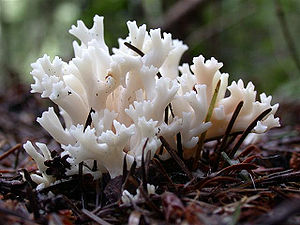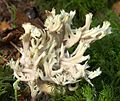Club mushrooms
| Club mushrooms | ||||||||||||
|---|---|---|---|---|---|---|---|---|---|---|---|---|

Comb-shaped club mushroom ( Clavulina coralloides ) |
||||||||||||
| Systematics | ||||||||||||
|
||||||||||||
| Scientific name | ||||||||||||
| Clavulina | ||||||||||||
| J. Schröt. |
The club mushrooms or coral mushrooms ( Clavulina ) are a genus of mushrooms from the family of club mushrooms relatives . The "real" corals ( Ramaria ) from the mushroom kingdom, on the other hand, belong to the pig's ear relatives (Gomphaceae) and, despite the similarly shaped fruiting bodies, are not closely related to the Clavulinaceae. The two genera are also subject to different orders.
The type species is Clavulina cristata , the comb-shaped club mushroom .
features
Macroscopic features
In this genus there are more and less strongly branched coral-shaped, but also club-shaped, unbranched and even purely resupinate species . Club-shaped fruiting bodies are usually clustered together and reach a height of about 10 cm. They have a smooth to wrinkled surface and a soft, waxy, but not fragile consistency. The colors differ, but the meat is always white to dirty gray. The spore powder leaves a white imprint.
Microscopic features
On the cylindrical to narrowly club-shaped, two to six-pored basidia depending on the species, approximately spherical to broadly ellipsoidal, thin and smooth-walled spores mature. They are hyaline , filled with a large drop of oil. The curved sternigmas of the basidia are striking and typical of members of the club mushroom relatives.
Generic delimitation
Some species of the genus Clavulina , the coral-shaped fruiting body form , can with species of the genus Ramaria be confused. The latter, however, has an ocher-colored spore powder, which can be seen in the lower branch forks of older fruiting bodies. In addition, the Clavulina species can be recognized by smooth, broadly ellipsoidal to subglobose spores, while the spores of the representatives of the genus Ramaria are ornamented and elongated.
Resupinate members of the genus Clavulina are very similar to the ectotrophic members of the genus Membranomyces , and can be distinguished by the absence of buckles in the latter with the aid of the microscope.
Ecology and phenology
Native coral fungi occur in deciduous and coniferous forests and form ectomycorrhizae. In the tropics, coral fungi are important ectomycorrhizal fungi and can even develop their mycorrhiza on adventitious roots in the crown area.
In Europe they can be seen scattered in small groups from July to December.
species
Around 75 species are known worldwide. The main area of distribution is in the tropics. In Europe 5 species occur or are to be expected there:
| Club mushrooms ( Clavulina ) in Europe |
|---|
Purple club mushroom
Clavulina amethystinaGray club mushroom
Clavulina cinereaComb-shaped club mushroom
Clavulina coralloidesWrinkled club mushroom
Clavulina rugosa
meaning
Coral mushrooms of the genus Clavulina are edible. They hardly smell and only have a very mild aroma.
swell
literature
- Stanisław Domański: Clavariaceae, Clavariadelphaceae, Clavulinaceae, Pterulaceae, Ramariaceae, Stephanosporaceae, Gomphaceae (II), Hericiaceae (II) . In: Mała flora grzybów . tape 1 , no. 4 . Warsaw 1984, ISBN 83-01-05555-3 .
- German Josef Krieglsteiner (Eds.), Andreas Gminder , Wulfard Winterhoff: Die Großpilze Baden-Württemberg . Volume 2: Stand mushrooms: inguinal, club, coral and stubble mushrooms, belly mushrooms, boletus and deaf mushrooms. Ulmer, Stuttgart 2000, ISBN 3-8001-3531-0 .
Individual evidence
- ↑ Jessie K. Uehling, Terry W. Henkel, M. Catherine Aime, Matthew E. Smith: New species of Clavulina with effused or resupinate basidiomata from the Guiana Shield. In: Mycologia . tape 104 , 2012, p. 547-556 .
- ^ Jason R. Thacker, Terry W. Henkel: New species of Clavulina from Guyana . In: Mycologia . tape 96 , no. 3 , 2004, p. 650-657 , doi : 10.1080 / 15572536.2005.11832961 .
- ↑ a b Jessie K. Uehling, Terry W. Henkel, Rytas Vilgalys, Matthew E. Smith: Membranomyces species are common ectomycorrhizal symbionts in Northern Hemisphere forests . In: Mycorrhiza . tape 22 , no. 7 , 2012, p. 577-581 , doi : 10.1007 / s00572-012-0457-8 .
- ^ A b Josef Christian: The genus Ramaria in Germany. Monograph on the genus Ramaria in Germany, with a key to the European species . 1st edition. IHW-Verlag, Eching 2008, ISBN 978-3-930167-71-5 , p. 1-352 .
- ↑ Mark Brundrett: Section 9. Ectomycorrhizal fungi. In: Mycorrhizal Associations: The Web Resource. 2008, accessed on March 28, 2020 .
- ↑ David A. Orlovich, Suzy J. Draffin, Robert A. Daly & Steven L. Stephenson: Piracy in the high trees: ectomycorrhizal fungi from an aerial 'canopy soil' microhabitat . In: Mycologia . tape 105 , no. 1 , 2013, p. 52-60 , doi : 10.3852 / 11-307 .
- ↑ Jessie K. Uehling, Terry W. Henkel, M. Catherine Aime, Rytas Vilglys, Matthew E. Smith: New species and distribution records for Clavulina (Cantharellales, Basidiomycota) from the Guiana Shield, with a key to the lowland neotropical taxa . In: Fungal Biology . tape 116 , 2012, p. 1263–1274 , doi : 10.1016 / j.funbio.2012.09.004 .
- ^ Paul M. Kirk, Paul F. Cannon, David W. Minter, JA Stalpers: Dictionary of the Fungi . 10th edition. CABI Europe, Wallingford, Oxfordshire (UK) 2008, ISBN 978-0-85199-826-8 (784 pages).
- ^ Jason R. Thacker, Terry W. Henkel: New species of Clavulina from Guyana . In: Mycologia . tape 96 , no. 3 , 2004, p. 650-657 , doi : 10.2307 / 3762182 .



